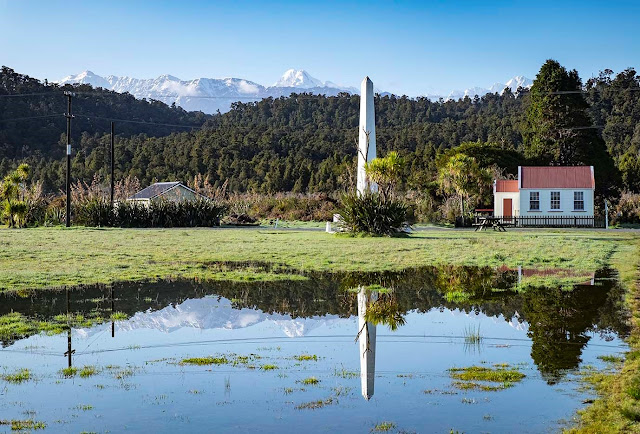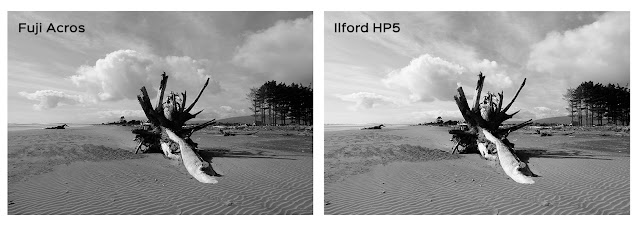My X-E2 'upgrade' continues. Sort of...
It's been almost two weeks since my last post - a post where I outlined my likely 'upgrade' path of my X-E2 to the more SLR-styled X-T20. A lot can happen in two weeks - and indeed a lot has happened. More than enough to make me want to change my mind about my last post. Let me explain...
 |
| Old School House, Okarito. Fujifilm X-E2 with XC16-50mm |
First, I should say that I don't disagree with anything I wrote in my last post here. I believe every word of it. If I was to 'upgrade' my X-E2 body, I would choose the X-T20 (considering present budget constraints). But I also said in my last post that I am not unhappy with my current X-E2, and that any upgrade was more for firmware/software reasons than any megapixel or performance update. Having established that, if I kept everything exactly as it was and simply swapped out the X-E2 for an X-T20, would I really notice a difference in my images? Seriously?
After some fairly serious self-reflection and a very timely youtube video (more on that later), I decide that the answer, if I was being honest with myself, was "No", I really wouldn't notice a difference in my images.
 |
| Carter's Beach, Westport. Fujifilm X-E2 with Fujinon XC16-50mm |
It was also about this time (last weekend as I write this to be exact), that I went out to make a vlog for my own youtube channel. I was going to compare three cameras to each other, with three different sized sensors. The Sony a99 24MP full-frame, the Fujifilm X-E2 with 16MP APS-C, and the Olympus OM-D E-M5 with a 16MP micro four thirds sized sensor. Having shot for years on all three sensor sizes, I was already fairly confident that my conclusion to the video would be that all three were fantastic and could do the job admirably. But that's not quite how it panned out!
 |
| 100% crops from the edge of images. Click for larger view. The X-E2 is noticeably blurrier. |
After setting up the exact same shot on all three cameras (a landscape at mid-apertures and a 28mm field of view), I took them home to process the RAW files and compare the results from the three sensors. Looking at 100% on all three files, the full frame Sony and the micro four thirds Olympus were nice and crispy across the frame (with an obvious edge to the Sony full frame). What shocked me, however, was how poorly my Fujifilm X-E2 image stacked up. It was so much softer than even the Olympus micro four thirds sensor, and the corners were horrible and smeary - particularly on the left side of the image. And this was at mid-range (f8), on a tripod, with a two-second timer to mitigate any camera shake.
 |
| 100% crops from centre. Click for larger view. The X-E2 is still softer than the Sony or Olympus! |
I don't for a moment believe that the 16MP X-Trans II sensor is actually that bad. So after getting over the initial shock (and yes, disappointment), wiser heads prevailed and I began to wonder why I had gotten such a poor result from the Fuji. And I think I've narrowed it down to two factors. One - the lens. And two - Adobe Lightroom.
Let's get number two out of the way first shall we. Lightroom. Ah yes, Adobe Lightroom. The bane of Fuji shooters. All Fujifilm shooters seem to struggle with Lightroom to process their RAF files. Apparently it has something to do with Adobe's de-mosaic algorithms (or something like that) not being compatible and requiring a complete re-write to fix? Which, if this is true, isn't surprising that Adobe is somewhat reluctant to go down that road. Which brings us to the conclusion that Adobe Lightroom is rubbish with Fuji RAW files - end of story. Can I attribute some of the lack-of-detail in the X-E2's image to Lightroom's poor conversion? Yes, I think I can. Am I going to do something about it - Yes. I think I am. In fact, I already have. I've installed Capture One Express for Fujifilm, and I will be experimenting with that for RAW conversions going forward.
So that's the processing sorted. What about the lens? I've always thought of the Fujinon XC16-50mm kit lens as a 'solid' performer - much better that most people give it credit for. In fact, I wrote glowingly about it here. But I've never really pixel-peeped the lens (I'm not a pixel-peeping kinda guy to be fair), and I've also mostly shot jpegs with it. When the camera processes a jpeg file, it gets rid of a lot of the inherent 'imperfections' the lens may have. Not so with a RAW file. You get to see the image captured warts-and-all. For better, or for worse... And I think that on this occasion, the XC16-50mm has certainly been found a little wanting. Ok. Maybe not too surprising. But what am I going to do about this one?
What does all that mean exactly? Well ok, I'll tell you what it means. It means that I've decided to keep my Fujifilm X-E2 - I LOVE the camera, and really don't see any reason to change it. BUT, I've also decided to invest my money where it actually counts - in the lens. And, inspired by Jamie, I've also decided that the lens should be a prime. One camera, one prime lens.
If I'm going to choose a prime lens, then as a landscape photographer it might behoove me to go for something wide-angle, like the Fujinon XF16mm f2 or XF18mm f2 (with their 'traditional' 24mm and 27mm fov respectively). Makes sense I guess? But remember, this is going to be my only lens, for everything - and I do like to photograph more than just landscapes occasionally. Photos of my grandson for instance. I'm not sure how successful it would be if I photographed family events and occassions with only a 24mm lens? So no, the 16 and 18mm lenses are out.




Really sad, you went from Fujifilm APS-C to Olympus MFT, Wayne.
ReplyDeleteI meant, that Sensor is extraordinary. You haven't used Capture One or Iridient X-Transformer before, to post-process the RAW Files, i might think. Because LR isn't the best choice, it never was. It does have since a few iterations, nowadays, a enhanced processing engine for Fujifilm X-Trans Sensor, but personally, i'd never go back from APS-C/FF to MFT, no offense.
But i can see your point, the gear, and into general, Lenses are lighter. I am reading your Site since ages here, i was very happy, to see all the Fujifilm stuff...Film Simulations, etc...and since a while, you're on MFT.
I'd like to add, that the bad edges is not the Fault of the X-E2, but blame the XC 16-50 Kitlens, which is one of the lowest spec'ed Lenses into the Fujifilm LineUp. I think, with the XF 18-55/2.8-4, or XF 16-55/2.8, things would being differently. It's a different thing, when you use the M5, but high quality Olympus (Pro) Lenses, for instance like the 12-40/2.8 Pro, this lens is for sure quite better, than the cheap XC 16-50 Kitlens, and faster too.
ReplyDeleteBest,
Marc